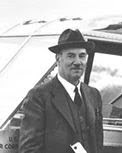
The de Havilland Mosquito, also known as the 'Mossie' to its many pilots and crews, or nicknamed the 'Wooden Wonder', since the majority of the fuselage was built out of plywood. The 2-engined Mossie was powered by two Rolls-Royce Merlin engines, although experimental designs and prototytpes featured Rolls-Royce Griffons and Napier Sabres. The fighter version's arnament usually consisted of four cannon guns and eight rockets/ eight bombs mounted under the wings on racks, or, as for the bomber version, just 8-12 bombs inside the cargo bay. The reconnaissance versions were unarmed. The fighter and bomber versions had 2 crew members: 1 pilot and 1 navigator/radio operator, as well as the reconnaissance versions.
The Mossie was designed by Geoffrey de Havilland without any requirements. When the design was proposed to the Air Ministry in 1936 they refused the design until 1940, where they decided that a fast multi- role aircraft that was faster than their main fighter, the Spitfire, would help their war progress. Due to severe bombings, only 20 were completed in December 1940 and so they moved to a blast-proof shelter, where construction sped up by 3 weeks. By 1941 the original order for 30 bombers, 30 fighters, 20 reconnaissance planes and, later on, 10 maritime Mossies were completed.
In 1943, when the US joined the war, the USAAF ordered 20 fighters and 10 bombers. By 1945, when the war ended, the USAAF had 30 fighters, 30 bombers and 30 reconnaissance, the Royal Canadian Air Force had 20 fighter- bombers (Developed in 1943), 20 fighters and 30 bombers, the Royal Australian Air Force had 10 fighter-bombers and 20 maritime planes. The RAF finished with a far superior amount, 100 fighters, 100 bombers, 60 fighter-bombers, 40 fast bombers, 100 maritime planes, 200 photo-reconnaissance planes and 100 fast photo-reconnaissance planes. Some 200 fast photo planes, armed with 2 10mm machine guns, were at first converted into trainers then at last, in 1942, were converted to British Overseas Airways Corporation (BOAC) as transports.




